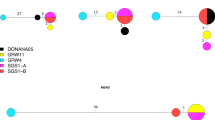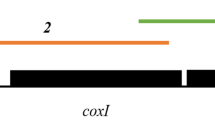Abstract
Acquiring genomic material from avian malaria parasites for genome sequencing has proven problematic due to the nucleation of avian erythrocytes, which produces a large ratio of host to parasite DNA (∼1 million to 1 bp). We tested the ability of laser capture microdissection microscopy to isolate parasite cells from individual avian erythrocytes for four avian Plasmodium species, and subsequently applied whole genome amplification and Illumina sequencing methods to Plasmodium relictum (lineage pSGS1) to produce sequence reads of the P. relictum genome. We assembled ∼335 kbp of parasite DNA from this species, but were unable to completely avoid contamination by host DNA and other sources. However, it is clear that laser capture microdissection holds promise for the isolation of genomic material from haemosporidian parasites in intracellular life stages. In particular, laser capture microdissection may prove useful for isolating individual parasite species from co-infected hosts. Although not explicitly tested in this study, laser capture microdissection may also have important applications for isolation of rare parasite lineages and museum specimens for which no fresh material exists.



Similar content being viewed by others
References
Bancroft JD (1967) An introduction to histochemical technique. Butterworth & Co., London
Bolger AM, Lohse M, Usadel B (2014) Trimmomatic: a flexible trimmer for Illumina sequence data. Bioinformatics 30:2114–2120. doi:10.1093/bioinformatics/btu170
Carlson JS, Giannitti F, Valkiūnas G, Tell LA, Snipes J, Wright S, Cornel AJ (2016) A method to preserve low parasitaemia Plasmodium-infected avian blood for host and vector infectivity assays. Malar J 15:154. doi:10.1186/s12936-016-1198-5
Clark NJ, Clegg SM, Lima MR (2014) A review of global diversity in avian haemosporidians (Plasmodium and Haemoproteus: Haemosporida): new insights from molecular data. International Journal for Parasitology. doi: http://dx.doi.org/10.1016/j.ijpara.2014.01.004
Freed LA, Cann RL (2006) DNA quality and accuracy of avian malaria PCR diagnostics: a review. The Condor 108:459–473
Garnham PCC (1966) Malaria parasites and other Haemosporidia. Blackwell, Oxford
Gurevich A, Saveliev V, Vyahhi N, Tesler G (2013) QUAST: quality assessment tool for genome assemblies. Bioinformatics 29:1072–1075. doi:10.1093/bioinformatics/btt086
Harrigan RJ, Sedano R, Chasar AC, Chaves JA, Nguyen JT, Whitaker A, Smith TB (2014) New host and lineage diversity of avian haemosporidia in the northern Andes. Evol Appl 7:799–811. doi:10.1111/eva.12176
Ishtiaq F, Beadell JS, Warren BH, Fleischer RC (2011) Diversity and distribution of avian haematozoan parasites in the western Indian Ocean region: a molecular survey. J Parasitol FirstView:1-11 doi: 10.1017/S0031182011001831
Langmead B, Salzberg SL (2012) Fast gapped-read alignment with Bowtie 2. Nat Methods 9:357–359. doi:10.1038/nmeth.1923
Lutz HL, Hochachka WM, Engel JI, Bell JA, Tkach VV, Bates SJ, Weckstein JD (2015) Parasite prevalence corresponds to host life history in a diverse assemblage of afrotropical birds and haemosporidian parasites. PLoS One 10:e0121254. doi:10.1371/journal.pone.0121254
Lutz HL, Patterson BD, Kerbis Peterhans JC, Stanley WT, Webala PW, Gnoske TP, Hackett SJ, Stanhope MJ (2016) Diverse sampling of East African haemosporidians reveals chiropteran origin of malaria parasites in primates and rodents. Mol Phylogenet Evol 99:7–15. doi:10.1016/j.ympev.2016.03.004
Nurk S, Bankevich A, Antipov D, Gurevich AA, Korobeynikov A, Lapidus A, Prjibelski AD, Pyshkin A, Sirotkin A, Sirotkin Y, Stepanauskas R, Clingenpeel SR, Woyke T, Mclean JS, Tesler G, Alekseyev MA (2013) Assembling single-cell genomes and mini-metagenomes from chimeric MDA products. J Comput Biol 20:714–737. doi:10.1089/cmb.2013.0084
Palinauskas V, Dolnik OV, Valkiunas G, Bensch S (2010) Laser microdissection microscopy and single cell PCR of avian hemosporidians. J Parasitol 96:420–424. doi:10.1645/GE-2247.1
Palinauskas V, Valkiūnas G, Bolshakov CV, Bensch S (2008) Plasmodium relictum (lineage P-SGS1): effects on experimentally infected passerine birds. Exp Parasitol 120:372–380. doi:10.1016/j.exppara.2008.09.001
Palinauskas V, Žiegytė R, Ilgūnas M, Iezhova TA, Bernotienė R, Bolshakov C, Valkiūnas G (2015) Description of the first cryptic avian malaria parasite, Plasmodium homocircumflexum n. sp., with experimental data on its virulence and development in avian hosts and mosquitoes. Int J Parasitol 45:51-62 doi: http://dx.doi.org/10.1016/j.ijpara.2014.08.012
Perkins SL (2014) Malaria’s many mates: past, present, and future of the systematics of the order Haemosporida. J Parasitol 100:11–25. doi:10.1645/13-362.1
Prugnolle F, Durand P, Neel C, Ollomo B, Ayala FJ, Arnathau C, Etienne L, Mpoudi-Ngole E, Nkoghe D, Leroy E, Delaporte E, Peeters M, Renaud F (2010) African great apes are natural hosts of multiple related malaria species, including Plasmodium falciparum. Proc Natl Acad Sci U S A 107:1458–1463
Ribeiro SF, Sebaio F, Branquinho FC, Marini MA, Vago AR, Braga EM (2005) Avian malaria in Brazilian passerine birds: parasitism detected by nested PCR using DNA from stained blood smears. Parasitology 130:261–267
Schaer J, Perkins SL, Decher J, Leendertz FH, Fahr J, Weber N, Matuschewski K (2013) High diversity of West African bat malaria parasites and a tight link with rodent Plasmodium taxa. Proc Nat Acad Sci 100:17415–17419. doi:10.1073/pnas.1311016110
Stevens A, Francis RJ (1996) Micro-organisms. In: Bancroft JD, Stevens A (eds) Theory and practice of histological techniques. Churchill Livingstone, New York
Telford SR (2009) Haemoparasites of the Reptilia: color atlas and text. CRC Press, Boca Raton
Valkiūnas G (2005) Avian malarial parasites and other Haemosporidia. CRC Press, Boca Raton
Waldenstrom J, Bensch S, Hasselquist D, Ostman O (2004) A new nested polymerase chain reaction method very efficient in detecting Plasmodium and Haemoproteus infections from avian blood. J Parasitol 90:191–194. doi:10.1645/GE-3221RN
Acknowledgments
This project was completed with support from the Athena Fund, the Cornell Lab of Ornithology, and the Cornell College of Veterinary Medicine (Ithaca, NY, USA), as well as by the Negaunee Foundation at the Field Museum of Natural History (Chicago, IL, USA). Funding was also provided by the European Social Fund under the global grant measure (VPI-3.1.-ŠMM-07-K-01-047) to the Lithuania Research Council. We would like to thank Johanna Dela Cruz, Paulina Pavinski Bitar, and Peter Schweizer for their assistance with technical aspects of LCMM, DNA extraction, and genome sequencing, respectively. We also thank the Wellcome Trust Sanger Institute for access to data from an unpublished Plasmodium relictum genome (raw data available via NCBI Accession Number PRJEB2579).
Author information
Authors and Affiliations
Corresponding authors
Ethics declarations
Compliance with ethical standards
Experimental procedures for this study were approved by the Ethical Commission of the Baltic Laboratory Animal Science Association (Lithuania) and Lithuanian State Food and Veterinary Office (Ref. no. 2012/01/04-0221), Lithuania. Experimental procedures conducted in the USA complied with IACUC permit 17601 UC Davis.
Rights and permissions
About this article
Cite this article
Lutz, H.L., Marra, N.J., Grewe, F. et al. Laser capture microdissection microscopy and genome sequencing of the avian malaria parasite, Plasmodium relictum . Parasitol Res 115, 4503–4510 (2016). https://doi.org/10.1007/s00436-016-5237-5
Received:
Accepted:
Published:
Issue Date:
DOI: https://doi.org/10.1007/s00436-016-5237-5




